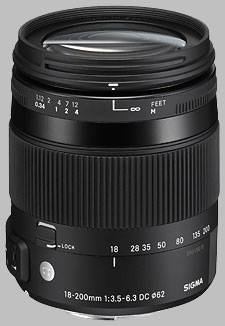| 18-200mm |
$399 average price |
|---|---|

|
|
Your purchases support this site
Canon EF-S - Black
(From Sigma lens literature) The Sigma 18-200mm F3.5-6.3 DC Macro OS HSM Contemporary lens, designed specifically for APS-C DSLRs, is the successor to the 18-200mm F3.5-6.3 II DC OS HSM, which was launched in 2011. The smaller and lighter lens (15.2 ounces and 2.8x3.4 inches versus 17.3 ounces and 3x3.5 inches) now features close up image capabilities with a minimum focusing distance of 15.4 inches and a maximum magnification ratio of 1:3, as opposed to the lens’ earlier minimum focusing distance of 17.7 inches and max magnification ratio of 1:3.8. Its minimum working distance is 14.7 inches, which makes the lens suitable for close-up shooting with natural light, keeping shadows of the camera and lens out of the image.
The 18-200mm F3.5-6.3 has also been updated to incorporate Special Low Dispersion (SLD) glass elements that have a high refractive index and can correct chromatic aberration at the telephoto-end. Moreover, aspherical lens elements, including double-sided aspherical lenses, will ensure a compact size and excellent correction of distortion.
The lens incorporates Sigma’s Hyper Sonic Motor (HSM) system to produce quiet, high-speed auto focus. In addition, it includes Super Multi-Layer Coating to reduce flare and ghosting, and to ensure high-quality images throughout the entire zoom range. The 18-200mm F3.5-6.3 DC OS HSM is also compatible with Sigma’s USB dock and the company’s Mount Conversion Service.
Sigma 18-200mm f/3.5-6.3 DC Macro OS HSM Contemporary
Your purchases support this site
Canon EF-S - Black
Sigma 18-200mm f/3.5-6.3 DC Macro OS HSM Contemporary User Reviews
-
FOUR super low dispersion glass and THREE aspherical elements. Macro capabilities. OS very good. Compact. Light weight. Sharpness very high.Very slow AF Busy bokeh, AF/manual focus ring rotates under your fingers during AF Awkward for manual focus
This is the fourth iteration of this 18-200mm lens by Sigma since the first reviews in 2005 (?). In the intervening years Sigma has made many improvements and added FOUR super low dispersion glass and THREE aspherical elements along with macro capabilities to this updated version that ultimately make a discernible difference in terms of sharpness, chromatic aberrations and distortion. I could not see any CA.
reviewed January 2nd, 2022
Sharpness was high at center and at the edges shooting wide open at 200mm, and the Macro focus bolstered by the Optical Stabilization of this lens is impressive to say the least.
Is it a perfect lens? No. While it is impressive in terms of sharpness and color rendition, the image stabilization (OS) in the lens is nowhere near the IBIS (in-body-image-stabilization) of an Olympus E-M1 or more recent cameras. To make the most it it requires a body with stabilization as well to work in tandem. I used it on a Sigma SD Quattro that has no IBIS, and while the OS in the lens is a big help you will not get 4 stops of stabilization (or more) that is now typical with so many other systems where lens OS is aided by IBIS.I was surprised that the OS worked as well as it did with the Sigma SD Quattro.
Beautiful, very sharp, image stabilized, and well balanced, the Sigma 18-200mm had a couple of deficiencies that made it completely unusable for wildlife shooting, which was my intended use. On the Sigma SD Quattro, its very slow AF in combination with the Sigma SD Quattro added up to nearly a 2.5 second delay from AF acquisition to actual capture. Additionally, the narrow AF/manual focus ring at the snout of the lens actually rotates under your fingers during AF travel (IN AF MODE!), which means you have to adjust your grip on the camera to avoid disrupting its auto-focus function. Manual focus is difficult and awkward due to the short Macro-to-infinity travel distance of the ring. Macro to infinity ring movement is just One-and-one quarter inches (8cm) in length.
Another issue is the bokeh, the out of focus areas in the background lack smoothness, and are very busy and distracting, especially in the highlights.
Overall the lens is well built, and compact. Although it is somewhat light in terms of weight, one can assume a good deal of plastics rather than metal (or brass) has been used, but this seems to be standard in terms of production costs and savings. Image quality was excellent. If AF had been very fast I would been temped to keep it due to its excellent image quality.